
Today’s Essential Topic for Electronic Musicians: MIDI Controllers.
Here’s just a taste of the absolute BEST stuff you’re about to discover:
- How Many Keys Do You Actually Need? – Get this wrong and you’ll end up wasting money and the precious-little space in your studio.
- DID YOU KNOW… There are actually 3 (very different) categories of MIDI contollers? Meet the series that has it’s own mini versions of ALL OF THEM!
- The Industry Standard For Ableton Live “Junkies” – if you use Ableton Live, you can stop reading right here, and pull out your credit card.
- PLUS…The “Ferrari” of MIDI Controllers – Got some BIG dollars to spend? I’ve got the perfect “toy” for you to spend them on.
Best Part: Just by skimming… through the headlines and pics, I can pretty much guarantee your “perfect controller” will practically be staring you in the face… almost immediately.
The Perfect Introduction to Pad MIDI Controllers
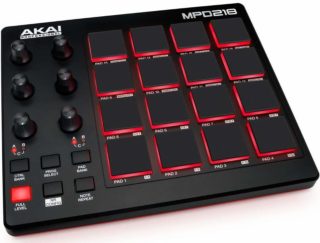
Next to keyboard controllers, the second most popular style of MIDI controller is the pad controller.
Popularized back in the 90’s by the original Akai MPC…
These pads have since become standard for drum beats, and controlling almost any type of percussion-based virtual instruments.
While early MPC’s where intended as full Music Production Centers…
The pad MIDI controllers of today, such the Akai Professional MPD18, are more versatile in that they can control almost any virtual instrument you choose.
Notable features of this model include:
- 16 velocity/pressure backlit sensitive pads
- 6 assignable potentiometers
- Ableton Lite
- iOS compatibility
- Plug-n-play USB connectivity
As a cheap and simple introduction to pad controllers, I highly recommend it.
- Akai Professional MPD18 – (Amazon/Sweetwater/Thomann)
Up next…
A Hybrid MIDI Controller with Both Keys and Pads
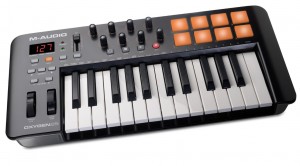
Since many electronic musicians end up using both keys and pads anyway…
Many new hybrid designs are becoming especially popular, since they combine many functions into a single unit.
The M-Audio Oxygen for example, features keys, pads, knobs, sliders, and even DAW control as well.
If you’re like most musicians and you hate programming MIDI, it’s also great because it auto-maps to all major DAW’s.
Currently it comes in 3 key sizes:
- 25 Key – (Amazon/Sweetwater/Thomann)
- 49 Key – (Amazon/Sweetwater/Thomann)
- 61 Key – (Amazon/Sweetwater/Thomann)
Up next…
A 3-Piece Pad, Keyboard, and Control Surface Set
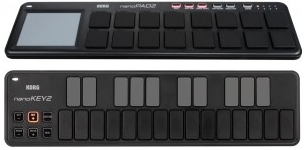
While hybrid MIDI controllers certainly have their advantages, they aren’t without drawbacks.
On certain occasions, you may need all the functionality you can get, but other times, small and simple would be much more convenient.
Luckily, with the Korg Nano Series, you can have both.
Because rather than combining all features into a single device, they created 3 separate mini devices that can be used either in tandem, or individually.
One is for keys, one for pads, and one for DAW control.
As you can see, these models save on space (and cost) by eliminating all but the most essential control features.
And while that can be bad if you need those features…It’s great if you don’t, because the simple layout is insanely easy-to-use.
Here’s the links:
- Korg NanoKEY2 – (Amazon/Sweetwater/Thomann)
- Korg NanoPAD2 – (Amazon/Sweetwater/Thomann)
- Korg NanoKONTROL2 – (Amazon/Sweetwater/Thomann)
Up next…
The Perfect Hybrid MIDI Controller for the Mobile Musician
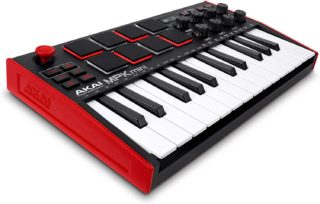
While MIDI controllers typically come in multiple key sizes to accommodate different users…
There are some controllers designed specifically for the mobile-musician, like the Akai Professional MPK Mini MKIII.
As you can see, this controller crams a wealth of great features into single a device so small, it fits your backpack.
In addition to the standard tools, it also features:
- a unique onboard arpeggiator for synth users
- a one-of-a-kind thumbstick that combines both pitch and mod functions onto a single control
…and comes with the following software:
- Akai Pro MPC Beats
- Hybrid 3 by AIR Music Tech
Overall, it offers some huge value at an incredibly low price.
Here’s the link:
- MPK Mini MKIII – (Amazon/Sweetwater/Thomann)
Up next…
A Hybrid MIDI Controller Designed for Ableton Live
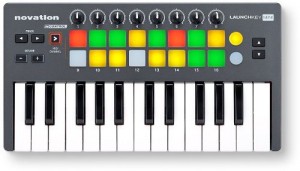
While most MIDI controllers are designed to work with all major DAW’s…
The Novation Launchkey is among the few designed just for Ableton Live.
While its InControl Technology does automap to other DAW’s as well…the best features of this controller are tailored for this one DAW.
The pads for example, can be used to trigger loops, call up presets, and conform to just about any control you want.
As a bonus, it includes an entire suite of software including:
- Launchkey/Launchpad iPad apps
- V-Station and Bass Station Soft Synths
- Ableton Live Lite
- Loopmasters Sample Pack
While I wouldn’t recommend it to everyone, it’s an obvious choice for users of Ableton Live.
- 25 Key – (Amazon/Sweetwater/Thomann)
- 37 Key – (Amazon/Sweetwater/Thomann)
- 49 Key – (Amazon/Sweetwater/Thomann)
- 61 Key – (Amazon/Sweetwater/Thomann)
- 25 Key Mini – (Amazon/Sweetwater/Thomann)
Up next…
A Pad Controller for Ableton Live
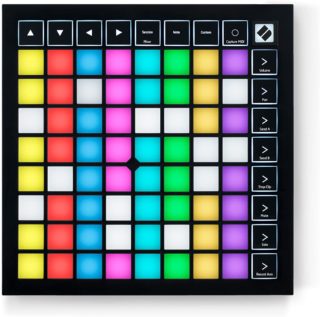
While you might call it the “pad-counterpart” to the Novation Launchkey…
The Novation Launchpad Pro is really an entirely unique control surface, unlike any we’ve covered so far.
Despite its resemblance to MPC’s of decades past…the pads of the Launchpad aren’t really designed to play two-handed rhythms like you would with most pads.
Instead, they are used to serve a much wider-variety of functions such as:
- manipulating clips
- triggering loops
- mixing
- firing-off effects
Just like the Launchkey, the Launchpad is intended primarily for Ableton Live…but also works well with other electronic DAW’s such as FL Studio and Reason.
Perhaps the greatest bragging right of the Launchpad is: it’s one of the few controllers regularly used by musicians with unlimited budgets…and is even used by many of the top names in music today.
Here’s the link:
- Novation Launchpad Pro – (Amazon/Sweetwater/Thomann)
For two similar options, also check out:
- Novation Launchpad Mini – (Amazon/Sweetwater/Thomann), which offers most of the same features, but is significantly smaller.
- Ableton Push 2 – (Amazon/Thomann), which has rave reviews, and is undoubtedly the most advanced (and most expensive) pad controller on the market.
Up next…
The Most Comprehensive MIDI Controller of Today
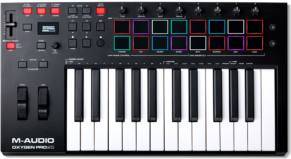
So far, all the controllers we’ve seen were designed with the primary goal of staying small and portable.
Because for most musicians, that’s a top priority.
However, in cases where it isn’t a priority, “Big” goes from being a problem to a luxury. Because more size also means more features.
And perhaps the best example today of such a controller is the M-Audio Oxygen Pro.
It has all the standard controls you’d expect from a full-featured MIDI controller, including a wealth of:
- knobs
- keys
- wheels
- pads
- sliders
- transport controls
And its Hypercontrol automatic mapping technology easily syncs with all major DAW’s.
Advanced playing features such as the Channel Aftertouch offer even more control and realism over.
Finally, it has semi-weighted keys and all 3 versions, which you almost never see in a keyboard MIDI controller.
Here’s the link:
- 25 Key – (Amazon/Sweetwater/Thomann)
- 49 Key – (Amazon/Sweetwater/Thomann)
- 61 Key – (Amazon/Sweetwater/Thomann)
Also check out a similar model in this category, the Novation Impulse which as you might guess, has many functions specific to Ableton Live.
- 25 Key – (Amazon/Sweetwater/Thomann)
- 49 Key – (Amazon/Sweetwater/Thomann)
- 61 Key – (Amazon/Sweetwater/Thomann)
By the way, if you found this post useful, I highly recommend joining our free Home Recording Secrets email newsletter where you’ll discover….
- How to Get Your First Studio Up and Running in a Single Weekend
- How to Avoid Wasting Thousands of Dollars on Unnecessary Pointless Purchases
- How to Get a “Million Dollar” Pro Studio Sound in a “Thousand Dollar” Home Studio
- PLUS… All Sorts of Other Amazing Insider Secrets Revealed
And it’s totally FREE! Click here and Enter Your Email to Sign Up.